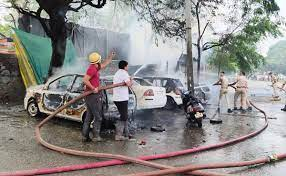
Table of Contents
Udaipur School
The recent incident in Udaipur, where a 15-year-old student was fatally stabbed inside a school, has triggered a series of violent reactions, including a mob setting cars on fire in response to the tragedy. This tragic event has not only highlighted serious issues within the educational system but also raised questions about communal tensions, law enforcement, and the broader societal impact of such incidents. This article delves into the details of the incident, its implications, and the urgent need for systemic changes to address such crises.
The Incident
On a seemingly ordinary day, the serene environment of a school in Udaipur was shattered by a horrific act of violence. A 15-year-old student was brutally stabbed within the confines of the school premises, leading to his immediate death. The exact motive behind this gruesome act remains under investigation, but initial reports suggest that it may be linked to personal disputes or deeper communal issues.
The attack, occurring within an educational institution, struck a nerve within the community, given that schools are typically considered safe havens for children. The nature of the violence and the young age of the victim have added to the shock and grief felt by the local population.
Immediate Aftermath
In the immediate aftermath of the stabbing, the situation escalated quickly. The emotional impact of the incident led to widespread anger and frustration among the community members. This emotional upheaval manifested in violent protests, with a mob setting several cars on fire. The destruction of property and the chaos that followed only added to the sense of insecurity and instability in the area.
The reaction from the mob was driven by a mix of outrage and a demand for justice. When such heinous acts occur, they often amplify existing tensions and lead to further violence, as communities seek to express their anger and demand accountability.
Communal Tensions and Social Unrest
This tragic event highlights underlying communal tensions that may exist in the region. Udaipur, like many places, has a complex social fabric with diverse religious and ethnic communities. While the immediate cause of the violence was the stabbing, the intensity of the mob’s reaction suggests that deeper, perhaps long-standing, grievances may have contributed to the situation.
In regions where communal tensions are high, incidents of violence can quickly escalate into larger conflicts. The burning of cars and the mob’s violent behavior reflect not just anger at the specific event but also a broader dissatisfaction with the social and political environment.
Law Enforcement and Security
The role of law enforcement in managing such situations is critical. In Udaipur, the response from the police and other authorities will be scrutinized for its effectiveness in handling the immediate violence and preventing further unrest. The challenges faced by law enforcement in such scenarios include:
- Maintaining Order: Controlling a violent mob requires a delicate balance between force and restraint. Excessive force can exacerbate tensions, while insufficient action can lead to further chaos.
- Investigation and Accountability: Ensuring a thorough and transparent investigation into the stabbing is essential for restoring trust within the community. The authorities need to address the root causes of the violence and hold the perpetrators accountable.
- Community Relations: Strengthening relationships with the community can help prevent the escalation of future incidents. Engaging with community leaders and addressing their concerns proactively can mitigate the risks of unrest.
Educational Institutions and Safety
The incident underscores the urgent need for improved safety measures within educational institutions. Schools should be sanctuaries where children can learn and grow without fear. To address safety concerns, the following measures should be considered:
- Enhanced Security Protocols: Schools must implement robust security measures, including surveillance systems, secure entry points, and regular safety drills. These measures can help prevent incidents and ensure a quick response in emergencies.
- Counseling and Support Services: Providing counseling and support services for students and staff can help manage the emotional impact of such incidents. Schools should have resources available to address trauma and support affected individuals.
- Conflict Resolution Programs: Implementing programs that teach conflict resolution and promote positive behavior can help prevent violence. Educating students about managing disputes peacefully and fostering a supportive school environment are crucial steps.
Broader Societal Implications
The Udaipur incident has broader implications for societal harmony and the effectiveness of the justice system. It serves as a stark reminder of the fragility of peace and the need for systemic reforms to address the root causes of violence. Key areas for consideration include:
- Addressing Social Inequality: Socioeconomic disparities can contribute to unrest and violence. Addressing these inequalities through inclusive policies and community development can help build a more equitable society.
- Strengthening Legal Systems: Ensuring that the justice system is fair, transparent, and effective in handling cases of violence is essential. This includes expediting investigations, ensuring fair trials, and providing support for victims and their families.
- Promoting Community Cohesion: Building bridges between different communities and fostering a culture of mutual respect and understanding can reduce communal tensions. Initiatives that promote dialogue and collaboration can play a significant role in preventing future conflicts.
Conclusion
The stabbing of a 15-year-old student in Udaipur and the subsequent violence highlight urgent issues within the community, the educational system, and the broader societal framework. The tragedy underscores the need for immediate action to address safety concerns, improve law enforcement responses, and address underlying communal tensions.
For legacy institutions, particularly schools, this incident serves as a wake-up call to prioritize student safety and well-being. For the community and authorities, it is a reminder of the importance of addressing grievances and fostering an environment of trust and cooperation.
Ultimately, while the immediate focus must be on addressing the aftermath of the incident and ensuring justice for the victim, it is equally important to work towards long-term solutions that address the root causes of violence and build a more peaceful and resilient society.









